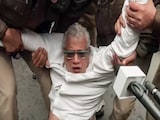- Richard Henry Lee proposed independence on June 7, 1776, in the Continental Congress
- Thomas Jefferson drafted the Declaration between June 11 and 28 with revisions by Adams and Franklin
- The colonies voted for independence on July 2, 1776, with New York abstaining
When Americans celebrate the 4th of July, they commemorate what they believe to be the birth of the United States. July 4, 1776, was the day the colonies declared independence from Great Britain.
The signing of the Declaration of Independence was the result of a month-long political process marked by debates, drafts, and key decisions.
Here is a look at the timeline of events that led to (and followed) July 4, 1776.
June 7, 1776: Call For Independence
The first formal step towards American independence came on June 7, 1776, when Virginia delegate Richard Henry Lee introduced a resolution in the Continental Congress declaring that "these United Colonies are, and of right ought to be, free and independent States."
Congress appointed a five-man committee: Thomas Jefferson, John Adams, Benjamin Franklin, Roger Sherman, and Robert R Livingston, to draft a document that would justify the break from Britain, in case the resolution passed.
June 11-28: Drafting The Declaration
Between June 11 and 28, Thomas Jefferson drafted what would become the Declaration of Independence. Jefferson's draft underwent several revisions with input from John Adams and Benjamin Franklin. By the end of June, the document was ready for presentation, but Congress had yet to vote on independence itself.
July 2: The Vote For Independence
The actual decision to break away from Britain occurred on July 2, 1776, when 12 of the 13 colonies voted in favour of Richard Henry Lee's resolution. New York abstained, pending instructions from its provincial convention. In a letter to his wife, Abigail, John Adams predicted that July 2 would be celebrated as the "great anniversary festival." He wasn't entirely wrong, only a little early.
July 4: Adopting The Document
On July 4, the Continental Congress reconvened to vote on the final text of the Declaration of Independence, incorporating various edits made over the previous days. That morning, the delegates approved the wording. This is the date printed on the first official copies of the Declaration, making it the day most associated with independence, even though the formal break had already occurred two days earlier.
The version approved on July 4 was sent to printer John Dunlap, who produced around 200 broadsides single-page printed copies of the Declaration - to be distributed across the colonies. These Dunlap Broadsides became the first published versions of the Declaration and are the reason the date July 4 gained iconic status.
July 5-8
On July 5, copies of the Declaration were sent to colonial legislatures, military leaders, and newspapers. The most dramatic moment came on July 8, when Colonel John Nixon publicly read the Declaration for the first time in the yard of the Pennsylvania State House (now Independence Hall).
The crowd reportedly erupted in cheers. Public celebrations followed in cities like Philadelphia and New York, where the British royal coat of arms was torn down.
August 2
Most delegates did not put pen to parchment until August 2, 1776. That is when Congress had the text engrossed, carefully handwritten on vellum, and presented for signatures. Some members signed later, depending on when they returned to Philadelphia. A few delegates, like New York's Robert R Livingston, never signed at all.















